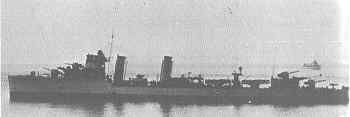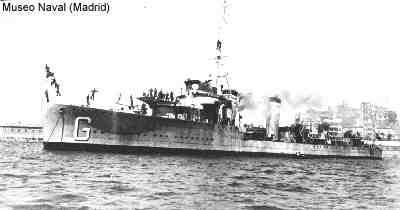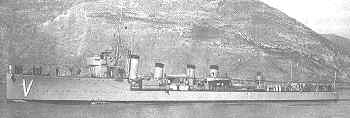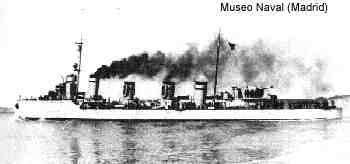

José Luis Díez
| Ships | Sánchez Barcaiztegui, José Luis Díez, Almirante Ferrándiz,
Lepanto, Churruca, Alcalá Galiano and Almirante Valdés (all in
the Republican Navy |
| Displacement | 1,536 tons standard, 1,800 full load |
| Dimensions | Length: 101.98 m (334' 6'') Beam: 9.67 m (31' 9'') Draft: 3.00 m (9' 10'') |
| Machinery | 2 Screws, Parsons Turbines, 4 Yarrow Boilers 42,000 HP.= +36 knots. 4,500 miles/14 knots |
| Armament | 5-4x120 mm (4.7'') / 50cal . -1-2x76 mm (3'') AA - 4 machine guns -6 torpedo tubes 533.4 mm (21'') (2 triple mounts) |
| Crew | 160 |

Almirante Antequera
| Ships | Almirante Antequera, Almirante Miranda, Gravina, Escaño, Ulloa,
Jorge Juan, Císcar (all in Republican Navy
|
| Displacement | 1,650 tons standard, 1,914 full load |
| Dimensions | Length: 101.98 m (334' 6'') Beam: 9.67 m (31' 9'') Draft: 3.00 m (9' 10'') |
| Machinery | 2 screws, Parsons Turbines, 4 Yarrow Boilers 42,000 HP.= +36 knots. 4,500 miles/14 knots |
| Armament | 4x120 mm (4.7'') / 50cal . -2x76 mm (3'') AA - 4 machine guns -6 torpedo tubes 533.4 mm (21'') (2 triple mounts) |
| Crew | 160 |
Their design was inspired by the British "Scott" class. So similar was their aspect to the Royal Navy destroyers that some degree of confusions occasionally resulted.
The first pair (the first Churruca and the first Alcalá Galiano) was sold to Argentina. The following fourteen were to be split in two groups. The later ships differed from their older sister and were fitted with a tripod mast, a more capable bridge and 120 mm armament. The guns were of a new type with larger shields. In the second batch only the Antequera was fitted with five 120 mm guns. During the war, most central guns were landed and used to complete the armament of other destroyers in the same class.
Churruca Class destroyers were excellent ships, quite fast and well armed, their only weakness being a lack of up-to-date antiaircraft armament when aviation was beginning to show its potential. All ships in the Churruca Class were built at Cartagena. The keel of the first destroyer in the first batch was laid in 1926 and six sister ships would follow between September 1928 and March 1933. In the second group, five destroyers entered service between May 1935 and the first months of the war, though some ships were initially fitted with 102 mm guns. The last two entered service in 1937.
All of these destroyers were used by the Republican Navy. The Císcar, however, was sunk by a bomb in Gijon and was refloated and incorporated in the National Navy in the last months of the war.
After the war two more destroyers were built (Alava and Liniers).
She was one of the most active ships in the war. This destroyer took part in the first operations off Gibraltar strait and the northern Spanish coast. Later she was used in several operations in the Mediterranean. In the battle off Cape Palos the Barcaiztegui fired four torpedoes at the Nationalist cruiser Baleares (some of them might have hit). She was badly damaged while in port at Cartagena by an aerial bomb in the last months of the war.


This ship was assigned to operations in the North, but with little success,
due to an inexperienced crew. When the Republic lost the North of Spain the
J. L. Díez fled to Falmouth and later to
Le Havre. In August 1938, the J. L. Díez attempted to
return to Cartagena(flying the British flag) (right picture), but was
intercepted by the cruiser Canarias and some destroyers near Gibraltar.
Crippled, the J. L. Díez escaped to Gibraltar. A new attempt was
frustrated by the Nationalist ships, and the Republican destroyer, damaged
again, deliberately ran aground in British waters for avoid the sinking (see
picture below). In March 1939, the British government decided to turn the ship
to the Nationalists.


Ferrándiz was used in the blockade of Gibraltar strait, where she was sunk by the Nationalist cruiser Canarias.

This destroyer was also very active in the war. The Lepanto followed
the Republican fleet to the North and took part in the battles of cape
Cherchell and cape
Palos. The torpedoes that sank the Baleares
were probably launched by the
Lepanto.
On 17-18 July 1936, her officers decided this destroyer was going to fight
on the Nationalist side, but the next day the crew mutinied and turned the ship
over to the Republicans. The Churruca was assigned to the blockade of
Gibraltar strait. In August 1937, she was torpedoed by an
Italian submarine but managed
to return to Cartagena.
She was the only Republican ship to attempt interception of the Nationalist
convoy on 20 August 1936, but she was confronted by enemy escort warships and
fled. The destroyer took part in convoy escort duties in the Mediterranean. In
June 1937, the Alcalá Galiano collided with a liner and was
later damaged in an air raid on Cartagena.
This destroyer escorted the Republican fleet to the North. After that she
took part in the battle of cape Cherchell,
and was used as a convoy escort

The Antequera was in Santander, when she joined the
Republican fleet blockading Gibraltar strait and later follow the rest
of the fleet to the North. Later she forced the Nationalist blockade of Gibraltar
strait and returned to Cartagena. The Antequera took part in
the encounters off cape Cherchell and
cape Palos (where she fired five torpedoes at
the Nationalist cruisers).
She was always kept in the Mediterranean sea, The Miranda was in
the battle off cape Cherchell.

This destroyer was laid up unfinished at Cartagena on 17 July 1936.
She was then completed and assigned to the blockade of Gibraltar
strait, where she was attacked by the
cruiser Almirante Cervera. The Gravina, despite the damage,
could manage to reach Casablanca. Later the Gravina was able to
rejoin the fleet at Cartagena. She was in the battles off Cape
Cherchell and Cape
Palos.

As with her sister Gravina, the Escaño was also laid up
unfinished at Cartagena. She was assigned to the operations in the North. The
Escaño was in the battle of Cape Cherchell.
She was damaged by a bomb some time after.
She was still under construction in Cartagena in 1936. The Ulloa took part to the operations in the Mediterranean sea.
This destroyer was also under construction at Cartagena when the war broke out. The Jorge Juan escorted convoys in the Mediterranean and took part in the battle off Cape Cherchell.

She entered service in the first months of the war. The Císcar was assigned to the North, but she only took part in a few operations. This ship was sunk by the Nationalist aviation in Gijon. In March 1938, she was refloated and and joined the Nationalist Navy.

Alsedo
| Ships | Alsedo, Lazaga (Republican Navy |
| Displacement | 1,145 tons standard, 1,315 full load |
| Dimensions | Length: 86.50 m (283' 9'') Beam: 8.23 m (27') Draft: 3.07 m (10' 1'') |
| Machinery | 2 Screws, Parsons Turbines , 4 Yarrow Boilers 33,000 HP.= +34 knots . 2,500 knots/14 knots |
| Armament | 3x101.6 mm (4'') / 50cal . -2x47mm AA - 4 machine guns -4 torpedo tubes 450 mm (17.7'') (2 double mounts) |
| Crew | 86 |
These destroyer design was a smaller version of the British Nimrod class. World War I delayed the completion of these ships. They were good destroyers, but too small and old compared to the more attractive Churruca Class. Therefore only three of them were ever built. Laid down in 1920 they entered service between September 1924 and August 1925.
She was at Cartagena at the outbreak of the war. The Alsedo was used in some operations near Gibraltar strait, but at the end of the war she was found moored at Cartagena in very poor conditions.

The Velasco was in El Ferrol on 17-18 July 1936. She was the only destroyer the Nationalists could count on at the beginning of the conflict.. The Velasco was one of the most active Nationalist ships. The destroyer operated mainly in the Bay of Biscay. This ship joined the España and Almirante Cervera in shore bombardments, blockades, freighter seizing, and skirmishes with enemy light forces. She mined many ports of the northern coast. In April 1938, she rescued the crew of the battleship España sunk by a mine off Santander. The Velasco was refitted in 1939.
More active that her sister ship Alsedo, the Lazaga was in the battle of Cape Palos. Later, due to some engine problems, she spent the last months of the war inactive at Cartagena.

Ceuta (the fourth funnel is mock)
| Ships | Ceuta, Melilla (Nationalist Navy
|
| Displacement | 1,400 tons standard, 1,800 full load |
| Dimensions | Length: 94,6 m (310' 4'') Beam: 9,4 m (30' 10'') Draft: 3,4 m (11' 2'') |
| Machinery | 2 Screws, Tosi Turbines , 5 Thornycroft Boilers 39,000 HP.= -34 knots. 1,700 knots/15 knots |
| Armament | 4x 120 mm (4'') / 45cal . -2x76mm AA - 4 machine guns -4 torpedo tubes 450 mm (17.7'') (2 double mounts) Until 50 mines |
| Crew | 160 |
In 1937 the Nationalist navy attempted to buy some destroyers from the Italian Navy. Due to money limitations and the little interest of the Italians, the only ships they obtained were these old destroyers and the Huesca class. They were very old in and their low speed and endurance did not allow them to be deployed besides the cruisers. They were originally named Velasco-Ceuta and Velasco-Melilla and a dummy funnel was added as a decoy to resemble Velasco.
She entered service with the Italian Navy in 1920 and in October 1937 was transferred to the Nationalist Navy. The Ceuta escorted convoys and was used in minor operations during the war. Her most important missions were the blockade of Gibraltar strait and the interception of the Republican destroyer José Luis Díez ,which was attempting to return to Cartagena.

The Aquila entered in service with the Italian Navy in 1917 and took part in World War I. The operational history of the Melilla in the Nationalists Navy is similar to that of her sister.

Huesca
| Ships | Huesca, Teruel (Nationalist Navy
|
| Displacement | 845 tons standard, 911 normal load |
| Dimensions | Length: 86 m (282' 2'') Beam: 7.90 m (25' 11'') Draft: 2.80 m (9' 2'') |
| Machinery | 2 Screws, Parsons Turbines , 5 Yarrow Boilers 20,000 HP.= 31 knots 2,100 knots/13 knots |
| Armament | 5x102 mm (4'') / 35cal . -2x37 mm AA - 2x20 mm AA -4 torpedo tubes 450 mm (17.7'') (2 double mounts). Until 42 mines |
| Crew | 130 |
As with the Ceuta class, these destroyers were aging ships purchased from the Italian Navy in October 1937: the Guglielmo Pepe became the Teruel and the Alessandro Poerio the Huesca. They entered in service in 1915 and took part in World War I.
The Huesca and Teruel were very old, therefore they were used as auxiliary destroyers. They seized some freighters. In May 1938, they collided accidentally. The Huesca took part in the interception of the Republican destroyer José Luis Díez